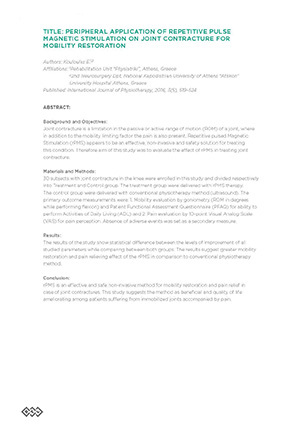Peripheral Application of Repetitive Pulse Magnetic Stimulation on Joint Contracture for Mobility Restoration
Efektivní a bezpečná neinvazivní metoda

Cílem této studie bylo zhodnotit vliv rPMS (repetitive peripheral magnetic stimulation - opakovaná periferní magnetická stimulace) na léčbu kloubní kontraktury.
Úvod
Joint contracture is a limitation in the passive or active range of motion (ROM) of a joint, where in addition to the mobility limiting factor the pain is also present. Repetitive pulsed Magnetic Stimulation (rPMS) appears to be an effective, non-invasive and safety solution for treating this condition. Therefore aim of this study was to evaluate the effect of rPMS in treating joint contracture.
Materiály a metody
30 subjects with joint contracture in the knee were enrolled in this study and divided respectively into Treatment and Control group. The treatment group were delivered with rPMS therapy. The control group were delivered with conventional physiotherapy method (ultrasound). The primary outcome measurements were: 1. Mobility evaluation by goniometry (ROM in degrees while performing flexion) and Patient Functional Assessment Questionnaire (PFAQ) for ability to perform Activities of Daily Living (ADL) and 2. Pain evaluation by 10-point Visual Analog Scale (VAS) for pain perception. Absence of adverse events was set as a secondary measure.
Výsledky
The results of the study show statistical difference between the levels of improvement of all studied parameters while comparing between both groups. The results suggest greater mobility restoration and pain relieving effect of the rPMS in comparison to conventional physiotherapy method.
Závěr
rPMS is an effective and safe non-invasive method for mobility restoration and pain relief in case of joint contractures. This study suggests the method as beneficial and quality of life ameliorating among patients suffering from immobilized joints accompanied by pain.
Publikováno v
International Journal of Physiotherapy, 2016, Vol. 3(5), p. 519–524
Více odborných studií